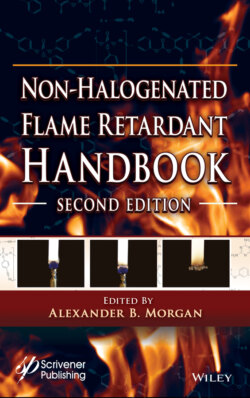Читать книгу Non-halogenated Flame Retardant Handbook - Группа авторов - Страница 10
Оглавление
Preface to the 2nd Edition of the Non-Halogenated Flame Retardant Handbook
Since the writing of the first edition in 2014, and the writing/publishing of this book in the 2020-21 timeframe, there have been some notable changes to the non-halogenated flame retardant field. Mostly, there have been an increase in regulations of flame retardant (FR) chemicals, further de-selection of chlorinated/brominated flame retardants, and some diversification of the flame retardants that exist in the “non-halogenated” category. Therefore, a need for a 2nd edition existed. This is actually quite rapid for the FR field and for generation of a 2nd edition of a book only 6 years after the publishing of the first, vs. the typical 10-15 years for FR book updates. FR technology tends to move at a slow pace due to flame retardant material science being a reactive field in response to regulations. Regulations take a notable amount of time to develop, be debated, and put into law, and so developments in FR chemistry in response to those regulations takes equally long. It can take even longer to take those developments out of the lab and scientific literature and then commercialize them.
The need of a book dedicated to non-halogenated flame retardant chemistry remains as strong as it did with the 1st edition, and this book includes chapters on FRs including Phosphorus-based (Chapter 2), Mineral-based (Chapter 3), Intumescent-based (Chapter 4), Nitrogen-based (Chapter 5), Silicon-based (Chapter 6), Boron-based (Chapter 7), and all the other non-halogenated FR systems which are not based upon the above elements (Chapter 10). All of these chapters existed in the 1st edition of the book, but each of these chapters has been updated for this book, and in some cases, significantly so. Chapter 10 is significantly revised, and includes bio-based FR chemicals, as well as some newer concepts. There are three new chapters in this book, including a chapter on regulations (Chapter 1), a chapter on conformal non-halogenated flame retardant coatings (Chapter 8), and a chapter on multi-component flame retardant systems (Chapter 9). Overall, the revised content in the chapters from the 1st edition, and the new chapters to this edition create an excellent contribution to flame retardant materials science. Or I hope you’ll come to that conclusion after you read the book.
As stated in the first edition, the fire threat for materials has not changed just because the regulatory environment around FR chemicals has. There is still a pressing need for flame retardant solutions for materials throughout modern society. One could argue that in some cases, with an increase in electrification of vehicles and buildings, that there may be more need, rather than less, for fire protection, and so non-halogenated solutions are part of that solution space. So with that, I believe you’ll find that this book is a single source of practical non-halogenated FR technology and information that will guide whatever research, development, testing, and evaluation (RDT&E) is needed for new fire safe solutions. I further believe that even with the many recent changes in regulations occurring as we speak, and in the years to come, that the book will still be very useful for many years beyond the 2021 publishing of this book.
As with all prefaces, I would like to thank those who helped make this book possible, especially the authors of the individual chapters who have taken time out of their busy lives to write the chapters. I also want to thank Scrivener Publishing again for their willingness to publish the 2nd edition. Special thanks goes out to Dr. Anteneh Worku of FR Adviser LLC and Dr. Adrian Beard of Clariant GmbH for helping review chapters in this book. I certainly must thank my (now retired) colleague, Prof. (emeritus) Charles Wilkie of Marquette University, for getting me started into flame retardant book publishing many years ago. This is now the sixth book I’ve edited, and my first one on my own. Chuck taught me how to navigate this area, and for this I’m quite grateful. Finally, I want to thank my wife, Julie Ann G. Morgan, for her continual support during my career, and for teaching me enough grammar that I can finally write on my own, although she may still take issue that I actually learned those lessons.
Alexander B. Morgan Dayton, Ohio, USA October, 2021
